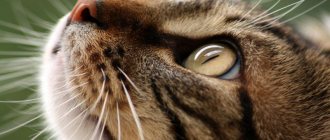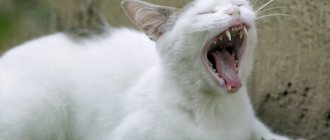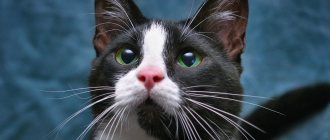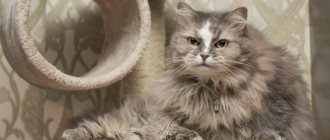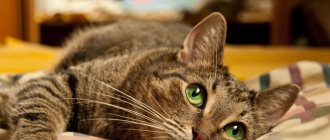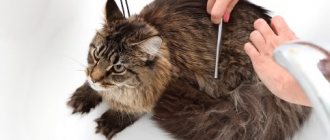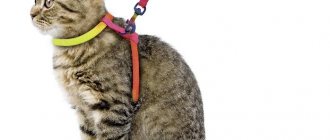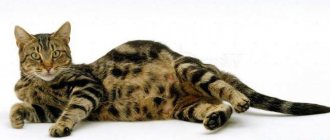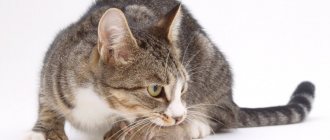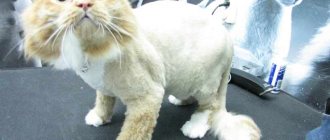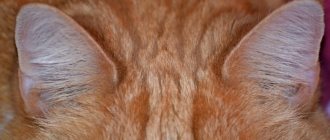Why do cats need whiskers?
All animals from the cat family have good hearing, a sense of smell and a specific organ called whiskers (vibrissae) in the form of coarse hairs near the mouth, which have a pronounced function of touch. The bases of the organ are located on the surface of the skin and are connected to a large number of nerve endings.
Vibrissae transmit special impulses to the brain to receive certain information. Therefore, if you cut off a cat’s whiskers, it may lose important functions for the body:
- orientation in the environment. It is with the help of their whiskers that cats are well oriented in the place where they are, since the whiskers transmit impulses about the presence of possible obstacles. The animal’s brain begins to solve the problem after receiving the appropriate signal;
- moving a cat at night. This function is especially useful for elderly animals whose visual acuity is impaired;
- successful jumping by cats, since with the help of their whiskers the animals accurately calculate the distance, trajectory and angle, the force of the body flight for successful hunting and protection when meeting an enemy;
- normalization of the vestibular apparatus, which ensures the animal’s balance while walking, jumping, running;
- the mustache is an integral assistant during hunting, since the sense of touch helps to establish the direction of the wind, the smell of the prey and its path of movement in complete darkness;
- With the help of their whiskers, cats can determine the depth of various holes. Reflective impulses from the walls transmit a signal to the brain, and the animal can assess the danger of a particular situation for itself;
- cats without whiskers cannot normally determine the temperature of food, liquids and recognize their nutritional characteristics;
You may be interested in: Why do cats purr and how do they do it?
- many experts confirm that with the help of their whiskers, cats can detect magnetic changes in the earth and predict meteorological weather conditions;
- one or another position of the whiskers may indicate the mood of the pet (spaced and raised whiskers indicate a strong interest in the cat, and if they are pressed to the muzzle, then the animal experiences a feeling of fear).
Therefore, if a cat’s whiskers are cut, the animal will lose all of the above functions, which will negatively affect its general condition.
What and why
It’s not for nothing that even in fairy tales it was emphasized: mustachioed and striped. Gorgeous long whiskers are a source of pride for a cat, and often for its owners. Yes, nature gave them for a reason. Let's first look at why a cat needs a mustache. In addition to their decorative function, they are also an organ of smell. They even have a second name, which is rarely mentioned in everyday life.
Consequences after trimming your mustache
Possible consequences after trimming a cat's whiskers can have varying degrees of complexity. At the same time, animals that live on the street will feel much worse, since with the loss of touch they lose the ability to hunt and good orientation in space.
A cat that is left without whiskers may not be able to navigate in space and recognize food by taste for a long time. The animal is constantly depressed and begins to be afraid of everything.
Studies have shown that animals without whiskers could not even walk normally in a straight line, fell for no reason and fussed due to a state of panic. Moreover, such cases are not recorded often, but cats still lose their functional characteristics until the whiskers are completely restored.
Veterinarians categorically prohibit cat owners from cutting off the whiskers, as the animals are subject to negative changes (unpredictable behavior, frequent falls, stress, excessive fearfulness, lack of contact, loss of an active lifestyle).
Differences from animal hairs
There are physiological characteristics. The vibrissae are planted very deep into the skin; these are not ordinary hairs at all. Each whisker is an antenna that is surrounded by nerve cells. This is necessary to transmit signals directly to the brain center. But that is not all. Vibrissae are equipped with muscle fibers.
That is, it is not hair at all, but rather complex receptors. In fact, they are responsible for the sense of smell, they just changed during evolution. The longest and most sensitive mustaches are located on top, shorter ones can be seen in the chin area. Remember that cats hunt at night, they need to quickly and silently find and catch a rodent. It is thanks to the whiskers that a cat can feel an object without contacting it and avoid colliding with an obstacle. What happens if you cut a cat's whiskers? He will lose a huge flow of information. Of course, this is not fatal at home, but it affects the well-being of the pet.
The main causes of breakage and loss of whiskers in cats
Whiskers and eyebrows in cats contain keratin, so if they break or are constantly falling out, you should study the possible causes of this condition:
- the development of vitamin deficiency, since the lack of essential vitamins and ascorbic acid in the animal’s body leads to insufficient production of keratin, which strengthens the pet’s mustache;
- the appearance of allergic reactions, which may be accompanied by mustache loss;
- disruption of the endocrine system (diabetes mellitus, lack of hormones also cause characteristic signs of withdrawal and loss of whiskers);
- the presence of various dermatological diseases (ringworm, parasite infection, fungus, other pathologies);
- Lack of sufficient collagen in the daily diet also affects whisker growth in animals.
A distinctive feature of Sphynx cats is the presence of short mustaches with curls, so for them this length is considered the norm and should not cause suspicion.
Most often, cats lose their whiskers when there are small children in the house who do not yet understand how serious animal twitching is. In such cases, you need to try to explain to the child that his actions are harmful to your beloved pet.
If the cat does not grow new whiskers, then he could damage the hair capsules, which contributed to normal growth and restoration of the whiskers. Therefore, consultation with a qualified veterinarian is required.
Causes of acne on the chin of cats
There are actually no known causes for cat acne on the chin. But some possible factors include:
- Stress
- Poor care
- Dermatitis
- Bacterial overload (eating from dirty bowls)
- Impaired production of sebum (fatty substance)
- Contact hypersensitivity
- Suppressed immune system
- Concomitant infection or disease
Plastic cat food bowls were once considered a possible cause of acne in cats (allergic or contact hypersensitivity). With new research, it is believed that the real problem is the level of bacteria found in plastic utensils. Switching to glass, metal or ceramic cookware can help get rid of acne in some cases. I recommend stainless steel
But it is equally important to wash bowls frequently, at least once a day. If you use plastic, use this tip first
If this is the reason, then improvements begin to be tracked after a week or a week and a half.
In addition to the above, think about raising food and water bowls. You should try to do this in such a way that the cat’s chin does not come into contact with the contents of the bowls.
Just like humans, cats develop acne due to allergies. You should change your cat's food and treats to make sure they don't contain the ingredient that is causing the allergic reaction. You would likely notice other allergic symptoms and signs if your cat had a food allergy or allergic contact dermatitis, but not always.
Diagnosis of acne and pimples in cats
Diagnosis of acne, as well as the diagnosis of acne in cats, should be carried out exclusively by a veterinary dermatologist. Only such a veterinarian is able to exclude other variants of dangerous diseases and problems, such as ticks, fungal and bacterial infections (primary or secondary), or fleas. Among other things, you need to accurately assess the cat’s general health and how much acne bothers her and how much discomfort it causes her. Research and diagnostic techniques include: skin scraping for microscopy, as well as culture to identify fungal spores and bacteria.
In severe cases where the skin is red and tender, a biopsy may be performed. This is necessary because acne can mimic other more serious ones.
How to help an animal that has lost its whiskers
Regular whisker loss in cats without an identified cause requires additional examination by a veterinarian. After receiving the results, appropriate treatment methods can be carried out:
- taking anthelmintic and antiparasitic drugs for therapeutic and preventive purposes;
- antihistamines to eliminate allergies and antibiotics to treat infectious diseases;
- vitamins, minerals to strengthen and restore immunity.
Creating favorable living conditions for your pet:
- eliminating excessive dryness in the room when using a humidifier;
- ensuring that bathing is not too frequent and using special shampoos;
- the use of fatty acids (biotin, taurine) in compliance with the dosages prescribed by the veterinarian, since an excess amount of drugs can have the opposite effect;
- eliminating stress factors for your pet;
- use of high-quality animal feed;
- ensuring water balance (regular fluid intake by the cat throughout the day).
Recommendations for eliminating this problem if your cat’s whiskers fall out for various reasons:
- using cheap food for the animal, since such products are of poor quality and can negatively affect the general condition of the pet;
- regular treatment of the coat against parasites, fleas and ticks;
- processing raw meat to destroy helminth eggs that may be contained in it;
- excluding aggression towards the cat from other family members (young children);
- addition of various vitamin complexes to the daily diet of cats;
- regularly providing the required amount of drinking water for the animal, since its lack contributes to the development of urolithiasis and other problems;
- visit the veterinarian at least 2 times a year to assess the general condition of the pet;
- excluding the trimming of whiskers in cats, since even a slight shortening of the length can cause the development of negative consequences.
Whiskers for cats are one of the important organs that provide touch, so their damage becomes the cause of many disorders in the body. Vibrissae require careful care and control on the part of the pet owner to maintain the good condition of the animal.
Causes of acne on the chin of cats
There are actually no known causes for cat acne on the chin. But some possible factors include:
- Stress
- Poor care
- Dermatitis
- Bacterial overload (eating from dirty bowls)
- Impaired production of sebum (fatty substance)
- Contact hypersensitivity
- Suppressed immune system
- Concomitant infection or disease
Plastic cat food bowls were once considered a possible cause of acne in cats (allergic or contact hypersensitivity). With new research, it is believed that the real problem is the level of bacteria found in plastic utensils. Switching to glass, metal or ceramic cookware can help get rid of acne in some cases. I recommend stainless steel
But it is equally important to wash bowls frequently, at least once a day. If you use plastic, use this tip first
If this is the reason, then improvements begin to be tracked after a week or a week and a half.
In addition to the above, think about raising food and water bowls. You should try to do this in such a way that the cat’s chin does not come into contact with the contents of the bowls.
Just like humans, cats develop acne due to allergies. You should change your cat's food and treats to make sure they don't contain the ingredient that is causing the allergic reaction. You would likely notice other allergic symptoms and signs if your cat had a food allergy or allergic contact dermatitis, but not always.
Diagnosis of acne and pimples in cats
Diagnosis of acne, as well as the diagnosis of acne in cats, should be carried out exclusively by a veterinary dermatologist. Only such a veterinarian is able to exclude other variants of dangerous diseases and problems, such as ticks, fungal and bacterial infections (primary or secondary), or fleas. Among other things, you need to accurately assess the cat’s general health and how much acne bothers her and how much discomfort it causes her. Research and diagnostic techniques include: skin scraping for microscopy, as well as culture to identify fungal spores and bacteria.
In severe cases where the skin is red and tender, a biopsy may be performed. This is necessary because acne can mimic other more serious diseases that should be ruled out first. It could be ringworm, skin mites, or even fungal yeast infections. All of this should be ruled out before any treatment is started.
Here are more photos of symptoms and signs of acne and pimples on the chin of cats
What happens if you trim your mustache
The consequences of losses are difficult to predict; they are varied and depend on individual characteristics, whether the cat is a street or domestic cat.
What happens if you cut off a cat's whiskers?
- Pets will begin to look for secluded places and be reluctant to communicate with the owner.
- Street - will have problems finding food, will begin to miss the victim more often, remain hungry until the whiskers manage to grow back.
Navigation disorders are the answer to the question of what will happen if cats' whiskers are trimmed. For some time, the animal will lose the ability to easily navigate the space around it.
- inability to walk in a straight line;
- frequent falls;
- collision with furniture;
- various injuries.
Failure in behavior is associated with the absence of habitual signals about obstacles and health hazards. Such deviations are not typical for everyone. In most cases, the problem manifests itself as difficulty in jumping, free orientation in the dark, or in unfamiliar surroundings.
Vibrissae help cats maintain perfect balance
Experienced breeders report the following deviations in the behavior of young animals and adult pets, which will happen if you cut off a cat’s whiskers:
- inappropriate behavior based on stress and fearfulness;
- lack of contact, withdrawal into oneself;
- lack of physical activity;
- increasing the amount of sleep.
Important! Comfortable conditions for a cat that has lost its whiskers will make it possible to reduce the risk of injury, but will not ensure its peace of mind.
What are whiskers needed for, and how does a cat use them?
Why do cats need whiskers? With their mustaches and eyebrows they “feel” the nearby space, receiving additional information about it. Vibrissae allow a small predator to:
- Determine the distance to objects and their size. For example, with their help, a cat, approaching a hole, can correlate its size with the width of its own body and decide whether it should try to get inside.
- Orientate yourself in space even in the dark. By analyzing information from the vibrissae and other sense organs, the brain creates the most complete picture of the surrounding world. In the dark, cats see better than people, but the main helpers in conditions of limited visibility are not their eyes, but their whiskers.
Why cats shouldn't have their whiskers trimmed
Help cats find food.
Pets are hunters by nature. But they track prey not only visually and by smell. Thanks to their whiskers, they are capable of tactile senses, which allows animals to react to various movements of the prey they are waiting for.
After finishing a hunt for a mouse, for example, a cat, by running its whiskers over its body, checks in this way whether the food it has caught is alive. Intuitively, animals feel that they should not swallow their prey alive. And rightly so: such a maneuver threatens the pet with the formation of microcracks in the oral cavity and the introduction of infection into the body through them.
Help cats navigate.
Cute “fluffies” also navigate their territory thanks to their mustaches. If a cat accidentally gets lost or ends up in a dark place, it will be his whiskers that will help him get out, playing the role of a compass and leading the animal to the right road. The pet will wander slowly, bending its head and leaning its whiskers to the ground, thus better guessing the path.
Help the owner understand the cat’s state of mind.
An experienced owner will always be able to determine the mood and intentions of his pet by looking at his mustache. The “cheerful” whiskers indicate that the cat is in a good mood and is ready to respond to the call to play and socialize. But mustaches sticking out in different directions betray hidden aggression and a desire for privacy. Lowering and pressing its antennae to its cheeks, the pet is worried about something.
If during a fight a rival gnaws off a cat's whiskers, the cat will lose confidence in its abilities and give up ground when retaking territory. And here the answer to the question whether it is possible for a cat to cut its whiskers reveals itself - it will be like chewing them off.
Do cut vibrissae grow back and how quickly?
Will a cat grow whiskers if for some reason she loses them? Fortunately for cats, the whiskers tend to regenerate. This happens if the hair follicle is not damaged. The cut antennae fall out over time, and new ones grow in their place. They usually grow back in 2-3 weeks. Under no circumstances should you force events by trying to pull out damaged vibrissae.
Many people wonder what will happen if a cat’s whiskers are trimmed and whether this will change the well-being of the pet. Moreover, this organ performs important functions in the body of animals from the cat family, so this aspect requires more detailed consideration and study.
Not whiskers, but vibrissae!
When talking about a cat's whiskers, they mean the long, coarse hairs located on both sides of the animal's nose. Scientifically they are called vibrissae, and they are found not only on the cheeks, but also near the eyes, on the lower jaw, tail, on the inside and on the pads of the paws.
These hairs are different from hairs. They are thicker and longer - the average length is 5-7 cm. The vibrissae are mobile - in the lower part of the connective tissue bursa, where the hair root is located, there are striated muscles and branches of the facial nerve. The cat can move them, point them forward or press them to the face. Vibrissae do not protect the body from overheating and hypothermia, like the hair that makes up the coat; they perform another important function.
So, why do cats need them? Vibrissae are modified tactile receptors. The name is derived from the Latin “vibrissae”, which means “to vibrate”, “to fluctuate”. The follicles of these hairs contain many nerve endings. They capture air currents from objects and send information about the world around them to the brain.
Interesting facts about vibrissae:
Maine Coon cat Missy from Finland
- The longest mustache (almost 20 cm), according to the Guinness Book of Records, belonged to a Maine Coon cat named Missy from Finland.
- They are thicker in cats than in cats.
- Vibrissae appear in kittens in the womb earlier than the hair that forms the coat.
Canadian Sphynx
- Representatives of some breeds, such as the Canadian Sphynx, do not have whiskers. The behavior of cats without whiskers is no different from the behavior of their whiskered counterparts. Scientists suggest that their absence is compensated by the high sensitivity of the skin.
- Mother cats often chew off their kittens' whiskers. Why they do this is not known exactly. According to assumptions, the animal is trying to protect curious cubs from the dangers of the outside world. A kitten, having lost its whiskers, feels insecure and does not move far from its mother.
- Their length in both directions corresponds to the width of the animal’s body.
Situations in the wild when cats deliberately deprive their relatives of their whiskers
As it became clear, whiskers are an important sensory organ; naturally, whiskers are well aware of this, so in nature there are situations when cats deliberately tear out the whiskers of their relatives . First of all, we are talking about a fight, then rivals may try to deprive each other of their mustaches precisely because they are so important. Their loss automatically means the cat is weak and becomes more vulnerable. In disputes over territory in the wild, this situation is not uncommon.
Science also knows of cases where a mother cat chewed off the whiskers of her children. This was due to the fact that she did not want the babies to leave the makeshift “nest” prematurely. A kitten whose ability to navigate due to deformation of its whiskers was weakened more often remained near its mother, because It’s warm around her and, most importantly, safe. New vibrissae grew within six months. And all this time the kitten was forced to stay near the parent. Despite the fact that the mother cat had good intentions in such situations, such behavior still has more of a negative impact than a positive one.
